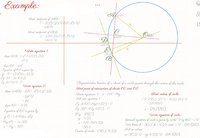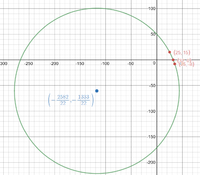Hard to say where you are going wrong, since you have not shared your efforts.
#1 Make SURE your three points are NOT collinear.
Otherwise, it's not possible.
#2a Quick estimate of Center...ummm...(25+35+32)/3 = 30.666... and (15 - 8 + 0)/3 = 2.333..., so (30.666..., 2.333...), then ask yourself if this is REALLY an estimate? It is. Don't be fooled. Make sure you know why. Since it is an estimate, how far can it be off? Ponder the radius.
#2b You may also wish simply to plot the points and eyeball an estimate of the center AND the radius.
This will empower you to know when you wander off.
#3 You need a Center (h,k) and a radius (r). Write the general equation, then plug-n-chug. No?
This may challenge your algebra skills.  Worst case scenario? Quadratic expressions.
Worst case scenario? Quadratic expressions.
#4 Interesting woodworkers' trick. Given points A, B, and C on a circle, construct the line segment AB. Construct the line segment AC. Construct perpendicular bisector of both AB and AC. The two bisectors intersect at the center of the circle. On a piece of wood, you just need a couple of lines with a straightedge and compass and a mark with a pencil. There is a little more effort to produce the exact analytical solution.



